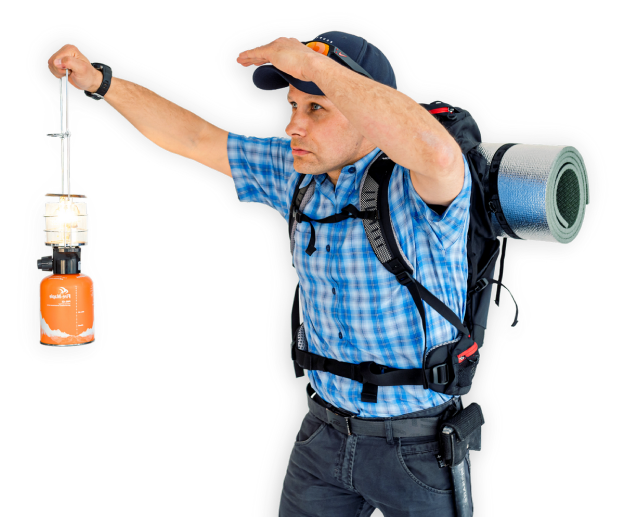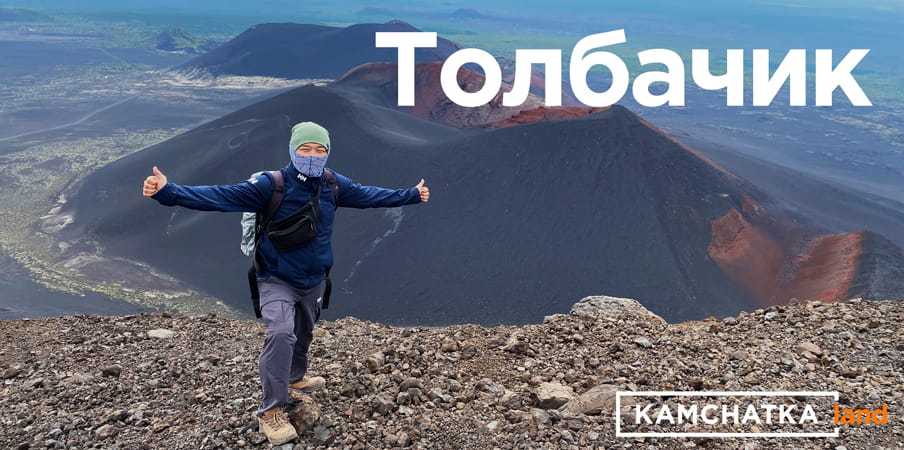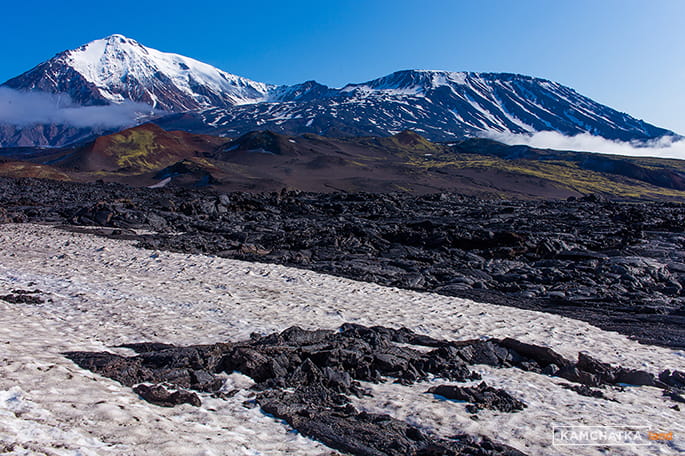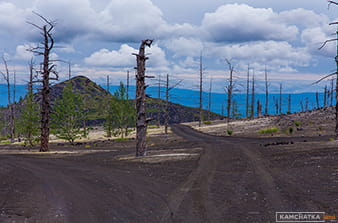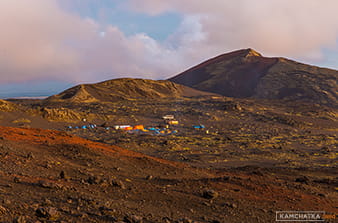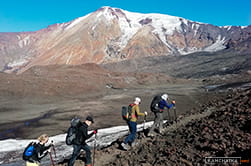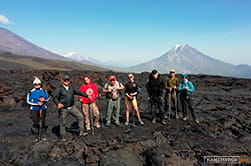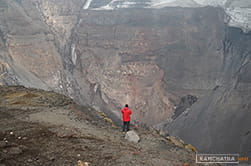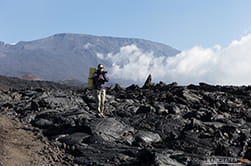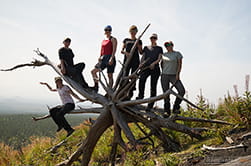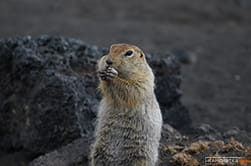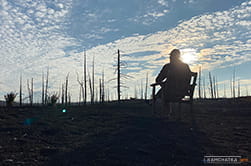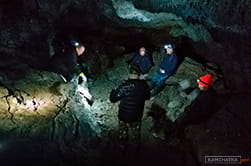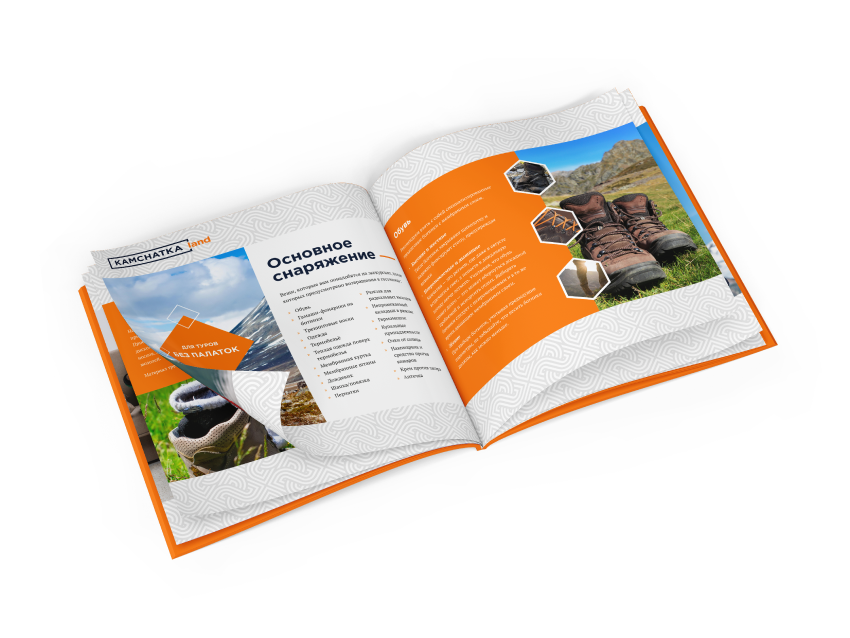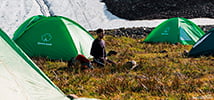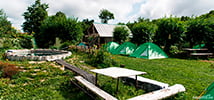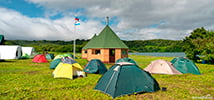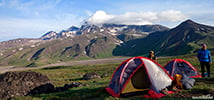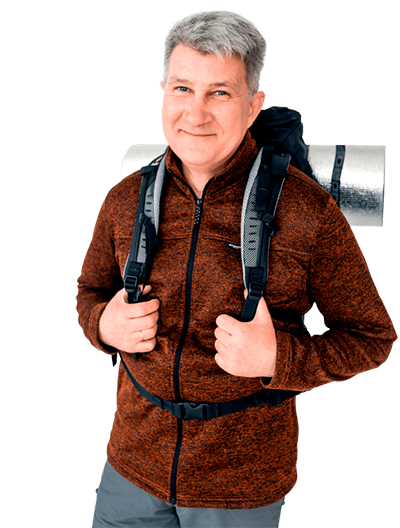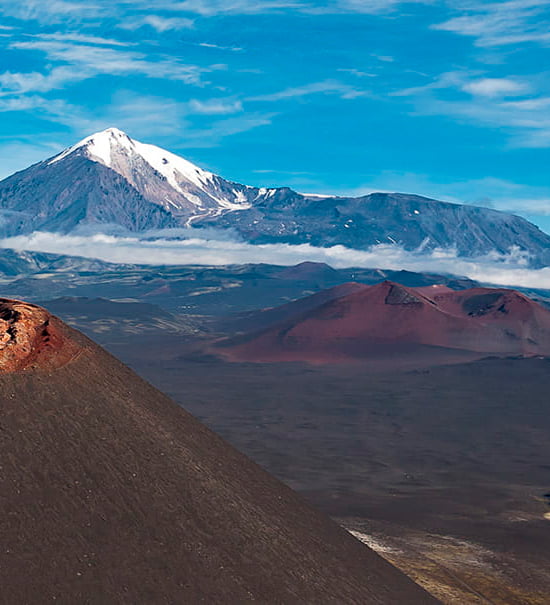
Ascent to Tolbachik vocano
Tour to Plosky Tolbachik volcano
Highlights
- A few days among the lunar landscapes at eruption sites
- Climbing an active volcano
- A walk through the Dead Forest
- Excursion to the cinder cones of the Northern breakthrough
Tour Info
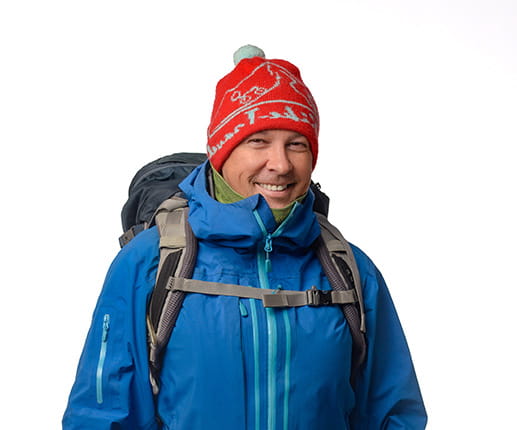
Maxim
Senior guide
Tolbachik is an active volcano, one of the giants of the Kliuchevskaya group in the north of the peninsula. Unofficially it is also called the Valley of Giants. The largest and most active volcanoes of Kamchatka are located here, but Tolbachik is the most famous among them.
aviasales.ru
Search for cheap flights
Climbing Tolbachik in 4 days
- Day 1. Transfer to Kliuchevskoy park. Kleshnya Camp
- Day 2. Ascent to the summit of Flat Tolbachik
- Day 3. Northern breakthrough, lava caves and Dead Forest
- Day 4. Return to the city
Day 1
Transfer to Kliuchevskoy park. Kleshnya Camp
Early morning group gathering. Our driver will drive us from Petropavlovsk-Kamchatsky to Tolbachik. Driving time is about 10-12 hours.
On our way we will make a stop for lunch in Milkovo village situated a bit closer to Petropavlovsk-Kamchatsky, 300 kilometer far away from the city. First the name of the village was mentioned by a famous explorer of Kamchatka, Stepan Krasheninnikov in his notes. The village can accept guests. There are hotels, historical museum, ethnographical center, kindergarten, as well as schools there.
We will reach the Tolbachinsky dale, the vast lava field in the evening. The dale is surrounded by the Tolbachik river valley from the southwest and by the Tolud river from the east. The Tolbachinsky dale is a high plain spreading over 40-45 kilometers southwest from the base of the volcano. The width is 30 kilometers. The true altitude ranges from 1800 to 2000 meters at the place where the dale merges with the volcano and from 80 to 120 meters at the place near the Tolbachik river. Some of numerous cones is higher than the dale, such as: The First and the Second cones of the Northern Fissure, the Vysokaya cone etc.
We will set up a camp near one of the cones – the Сlaw. After setting up a camp we will have dinner and go to sleep. We will have to get up early tomorrow.
Day 2
Ascent to the summit of Flat Tolbachik
After having breakfast we will go on our trip. In this day we will climb Plosky Tolbachik volcano. The path is created by solidified lava and cinder. The volcano has a flat top which forms the caldera of 3 kilometers in diameter. The caldera was practically filled in the result of numerous eruptions. The glacier is at the top of the volcano.
Before great eruption there was a small active crater (350 meters in diameter) till 1975, but after the great fissure eruption the part of the volcanic summit had been collapsed. Therefore the precipice of 1,8 kilometers wide was formed. At first the volcanologists were observing a lot of fumaroles and a forming crater lake with amazingly blue color. But this process had not come to an end and now there is no crater and the fumaroles don’t display any activities.
There is a large quantity of the cinder cones (more than 120) which are on the slopes of Plosky Tolbachik and Tolbachik Valley. The eruptions were recorded since 1740 to 1976 and it was mainly a kind of ash. Sometimes scientists notice the formation of the lake in the central crater. The most massive eruption happened in 1975 for the entire observation period. It was named as the Great Tolbachik Fissure Eruption. Just as a result of this dramatic event the cones of the North and South Breakthrough, which we will be able to see, were created. The last strong activity was recorded in 2012 and referred to the Fissure Eruption named “50th Anniversary of the Institute of Volcanology and Seismology”.
After climbing the top, we will have a lunch/snack. As well you will be able to enjoy stunning views from the summit. Next we will descent to the camp, have a dinner and spend the second night in tents.
Day 3
Cones of the North breakthrough. Dead Forest
After having breakfast we will go by vehicle to the cones of the Northern Breakthrough.
The Great Tolbachik Fissure Eruption is one of the most interesting places in the area and it had been lasting for one year and a half, from July 1975 to December 1976. As a result many different cones with height of 300 meters were created, including one of the largest cones, the Northern Breakthrough, and lava fields. Now the cone keeps its activity.
After driving to the place, where our trip starts, we will listen to safety instructions and begin our climbing the cones. The weather will most likely be foggy so you need to watch under your feet so that you can see fanciful forms of cinder and volcanic bombs, as well you will be able to feel sulfur smell. Moreover you will be able to feel the hot ground through your shoes with hard soles.
A trip around the Northern Fissure takes about 4 hours. After descending we will have lunch and go on our trip to the lava caves. Our next stop is the Zvezda (Star) cone. There we will walk around the Dead forest.
The Great eruption destroyed every living thing within a radius of the few kilometers. The forest was burnt: heartwoods were scorched; bushes, herbs were bared. Now this place is named Dead Forest. Before the eruption animals left their places because they feel a future danger thanks to their instincts.
The terrain became empty and looked like non-living endless dark fields. This landscape gave an idea to organize a test area for spacecrafts in the time of the Soviet Union. Thus the base was built for testing a moonprobe, and then it was moved to another place. However it is impossible to visit the old base because it was vanished under the lava in the time of the eruption of 2012. Returning to the camp. Dinner. Overnight in tents.
Day 4
Return to Petropavlovsk-Kamchatsky
After early morning group gathering we will be driven to Petropavlovsk-Kamchatsky. Travel time takes about 10-12 hours. On our way we will make a stop for lunch in Milkovo village.
Tour price
The cost includes:
- Meals on the active part of the tour (vegetarian meals are possible);
- Transfer from Petropavlovsk-Kamchatsky from Petropavlovsk hotel;
- Group equipment: tents, mats, tent canteen, etc. ;
The cost does not include:
- lunch on the road in the village of Milkovo and Sokochi (twice - on the first day and on the last day);
- Insurance (required);
Popular questions
What kind of insurance do you need?
Travel insurance must be taken out for the excursion. You can take out insurance for outdoor activities at any insurance company. The following options must be selected: ‘trekking‘/’mountain trekking up to 3500 m’. Other details are optional.
Hotels on tour
-
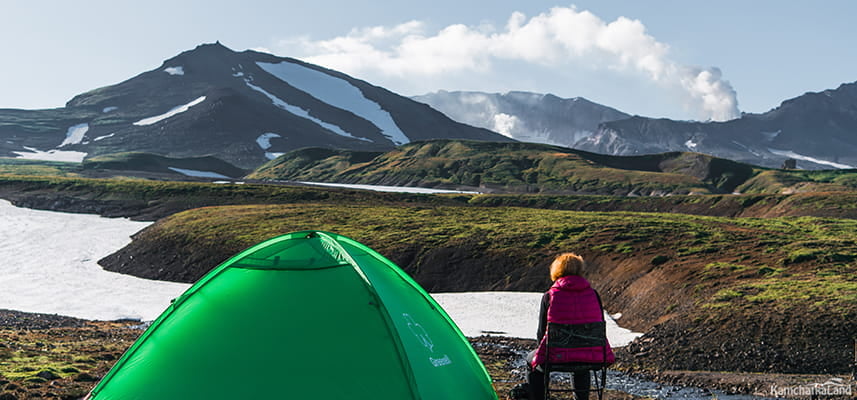
Tents
In nature
There are still places on the territory of Kamchatka where there is no infrastructure and accommodation only in tents is possible. Usually these are the most remote areas from civilisation, where most tourists do not visit. When visiting such locations we take with us tourist tents, as a rule, two-seater tents by Greenell. Tourists bring with them a sleeping bag, which is considered a personal item. It is not recommended to rent a sleeping bag. All belongings on our tours are transported by vehicle, you will not have to carry a heavy rucksack.
Write us
If you haven`t found a suitable tour in the general catalog, please send us your preferences and parameters for your future trip— dates, number of people. Our manager will be sure to make you a good offer.
Denis
